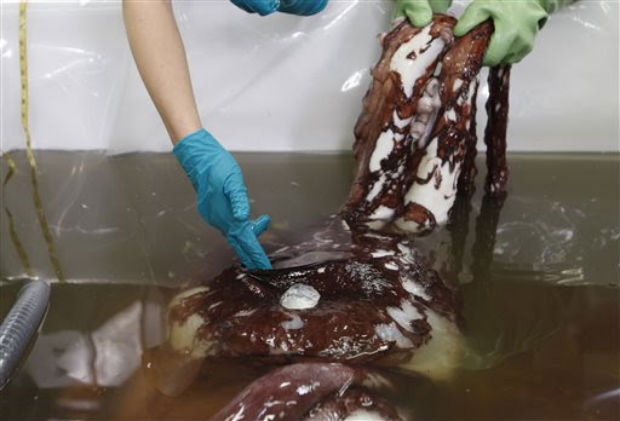Scientists’ colossal squid exam a kraken good show

Scientist Kat Bolstad, left, from the Auckland University of Technology, and student Aaron Boyd Evans examine a colossal squid at a national museum facility Tuesday, Sept. 16, 2014, in Wellington, New Zealand. The colossal squid, which weighs 350 kilograms (770 pounds) and is as long as a minibus, is one of the sea’s most elusive species. It had been frozen for eight months until Tuesday, when scientists in New Zealand got a long-anticipated chance to thaw out the animal and inspect it once they used a forklift to maneuver it into a tank. AP
WELLINGTON, New Zealand — It was a calm morning in Antarctica’s remote Ross Sea, during the season when the sun never sets, when Capt. John Bennett and his crew hauled up a creature with tentacles like fire hoses and eyes like dinner plates from a mile below the surface.
A colossal squid: 350 kilograms (770 pounds), as long as a minibus and one of the sea’s most elusive species. It had been frozen for eight months until Tuesday, when scientists in New Zealand got a long-anticipated chance to thaw out the animal and inspect it — once they used a forklift to maneuver it into a tank.
The squid is a female, and its eight arms are each well over a meter (3.3 feet) long. Its two tentacles would have been perhaps double that length if they had not been damaged.
Kat Bolstad, a squid scientist from the Auckland University of Technology who was leading a team examining the creature, described it as “very big, very beautiful.”
“This is essentially an intact specimen, which is almost an unparalleled opportunity for us to examine,” she said. “This is a spectacular opportunity.”
Article continues after this advertisementMany people around the world agreed: About 142,000 people from 180 countries watched streaming footage of the squid examination on the Internet.
Article continues after this advertisementColossal squid sometimes inhabit the world of fiction and imagination, but have rarely been seen in daylight. Remarkably, Bennett and his crew on the San Aspiring toothfish boat have caught two of them. Their first, hauled in seven years ago, is on display in New Zealand’s national museum, Te Papa.
Bennett said there was so much excitement about his previous catch, he thought he had better save the latest one for research.
“It was partly alive, it was still hanging onto the fish,” Bennett recalls. “Just a big bulk in the water. They’re huge, and the mantle’s all filled with water. It’s quite an awesome sight.”
Susan Waugh, a senior curator at Te Papa, said scientists hope to find out more about where the creature fits in the food chain, how much genetic variation there is among different squid types, and basic facts about how the colossal squid lives and dies.
She said scientists plan to further assess the condition of the squid before determining whether to preserve it for public display.
Bolstad said it’s possible that ancient sightings of the species gave rise to tales of the kraken, or giant sea-monster squid. She said sperm whales often eat colossal squid and are known to play with their food, and sailors may have mistaken that for epic battles.
“On the other hand, we don’t really know what the grog rations were like at that time at sea, either,” she said. “So it may be that we’ve got a bit of a fisherman’s story going on there, too.”